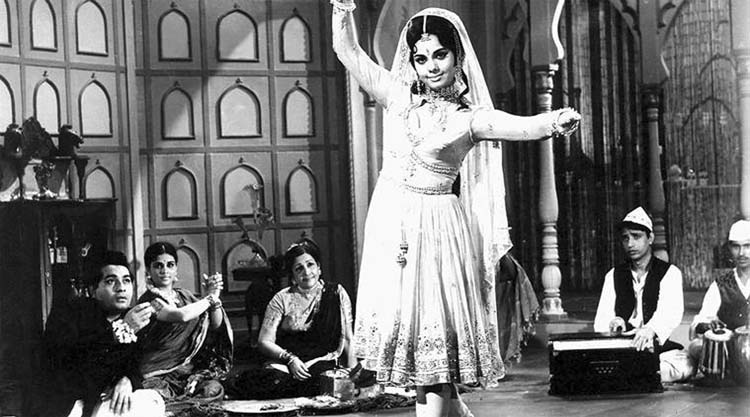
What drew you to examine the role of courtesans in Indian cinema?
My earlier book, Gender, Sex and the City (2012) was on non-mystical Urdu poetry from Lucknow in the 18th and 19th centuries. This poetry described the everyday lives and loves of urbanites, both women and men. Reading poetry and prose from this time, I realised that courtesans were female intellectuals and artistes, prosperous working women, the colleagues of male poets, and were often mentioned by name in poetry.
Historian Veena Oldenburg found that they were in the highest income-tax bracket in 19th-century Lucknow. I wondered where the witty, erotic and playful voices of courtesans went after their patrons dwindled and their profession was denigrated, regulated and gradually erased. I found that these voices resurfaced in different forms and spaces, including popular films and film songs.
At what point, during your research and writing, did the title Dancing with the Nation emerge?
My partner, Mona, suggested this title after reading a draft of the manuscript. Courtesans’ most significant role has been preserving, developing and transmitting traditions of poetry, music and dance, both to live audiences and to cinema viewers. They were among those who brought older aesthetic traditions to the new nation. Also, because of real-life tawaifs as well as courtesan characters in films, modern Indians, from the earliest days of cinema, were aware that women could live and travel independently, earn a substantial living, support their mothers and children, and form communities and relationships on their own.
You call the courtesan ‘voice of indigenous modernity.’ Why?
We think that modernity is the product of colonialism. This is not quite true. Pre-colonial cities like Delhi, Lucknow, Hyderabad and Banaras, had many markers of modernity such as flourishing markets and proto-consumerist cultures, sophisticated ideas about gender, sexuality and relationships, and above all hybridity of many kinds – regional, linguistic, religious and international. It was said that goods and people from all over the world could be found in the markets of Lucknow. Courtesans travelled widely and their households were spaces for elegant conversations on a host of topics; this is reflected in the poetry of the time.
How do you think this voice was muffled?

In north India, after the defeat of the 1857 revolt, the colonial rulers smashed this indigenous modernity. It was replaced by colonial modernity – educated urbanites now internalised Victorian norms and grew embarrassed about their own social institutions and literature, especially erotic and playful literature that came to be labelled ‘obscene’. Courtesan households were among the institutions viewed as decadent and reformed out of existence.
However, courtesans were highly educated and resourceful. While some were forced into sex work, others moved into theatre, music recording and cinema. These were among the first modern urban women, shaping the most modern art form – cinema. Like their predecessors, they owned property and were glamourous figures, stars of the city. We see such characters in films such as Bank Manager (1959), Benazir (1964), Sunghursh (1968), and Salma (1985). In Salma, two tawaifs, one from Banaras and the other from Lucknow, engage in a musical contest, each extolling her own city.
The book mentions that courtesans played a significant role in setting up the film industry. Why was due credit never given?
Yes, women from tawaif backgrounds were the first woman directors, producers, singers, actors and choreographers in the movies. Fatima Begum was the first-ever female director – she launched a production company in her own name and made eight silent films (including Bulbul-e-Paristan and Goddess of Luck). Jaddan Bai (Nargis’s mother) was another pioneer, who worked as an actor, singer, music composer, director and producer. Bibbo, an actor, singer and music director in the ’30s and ’40s (she acted in movies such as Sneh Bandhan, Jagirdar and Gramophone Singer), was the daughter of courtesan Hafeezan Bai of Delhi.
These women worked as colleagues with male directors, producers, script writers and lyricists, so the male filmmakers knew that they were strong women, and that knowledge is reflected in the courtesan characters we see in films such as Aadmi (1939), Raj Nartaki (1941), Kala Pani (1958), even Dream Girl (1970). Some women in films continued simultaneously living as tawaifs, which is depicted, though negatively, in Pati Patni aur Tawaif (1990). Later, when middle-class women took over these roles in film-making, while some women from tawaif backgrounds continued working in cinema but disowned their past, the early pioneers were often forgotten.
In spite of being independent and self-sufficient working women, what stops the films featuring courtesans from being counted as woman-centric movies?
A few unconscious biases – one bias leads us to pay more attention to films that focus on the hero, with the romantic heroine playing second fiddle to him. Another bias places courtesan films in a category of their own and not under heroine-centric films. Third, in films where hero and heroine are equally important, we tend to focus more on the hero, and label eras in cinema as defined by male actors like the Dilip Kumar era or the Amitabh Bachchan era. We could as easily term an era the Vyjayanthimala era or the Hema Malini era. Almost every major female actor has played this role at least once, and many courtesan films (apart from the over-examined Pakeezah and Umrao Jaan) were major hits, such as Sadhna (1958), Chitralekha (1964); Mamta (1966); Khilona (1970). n

